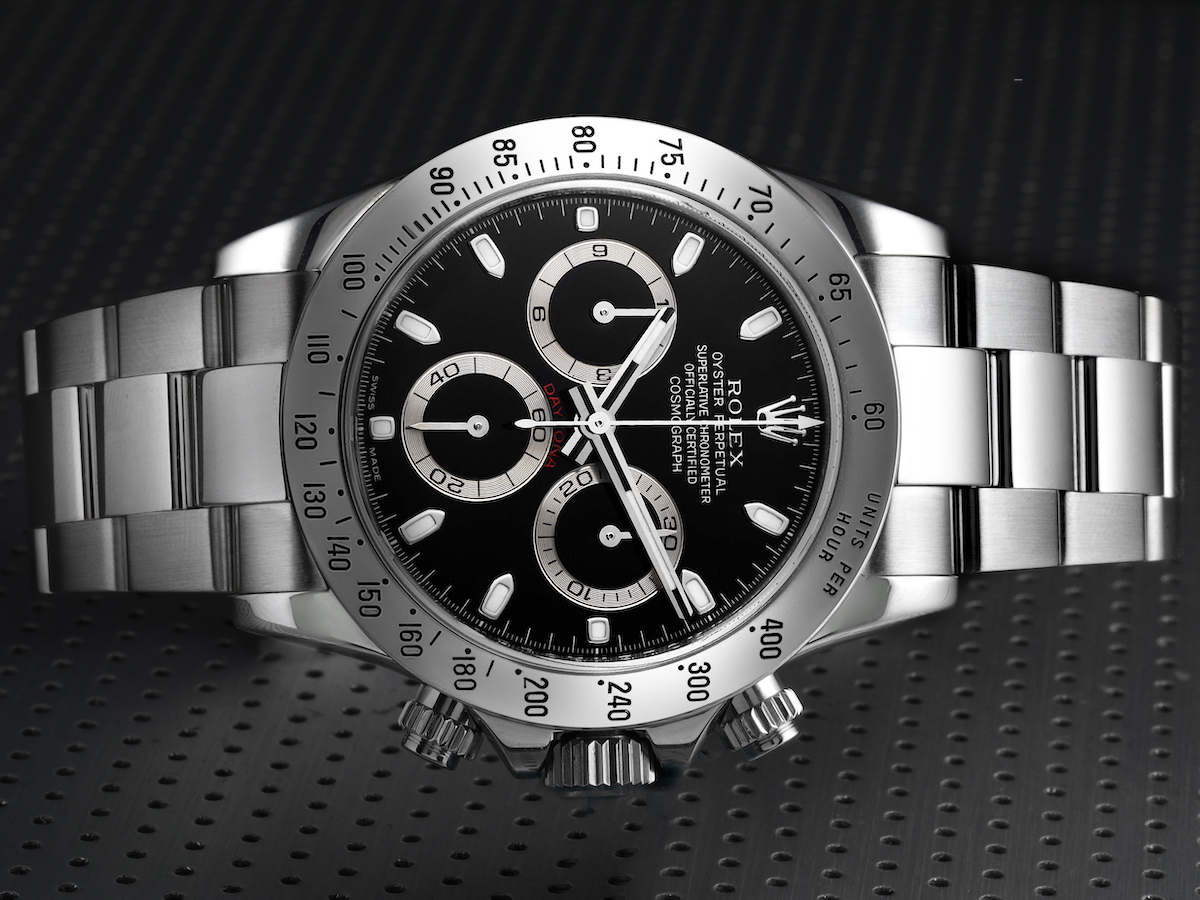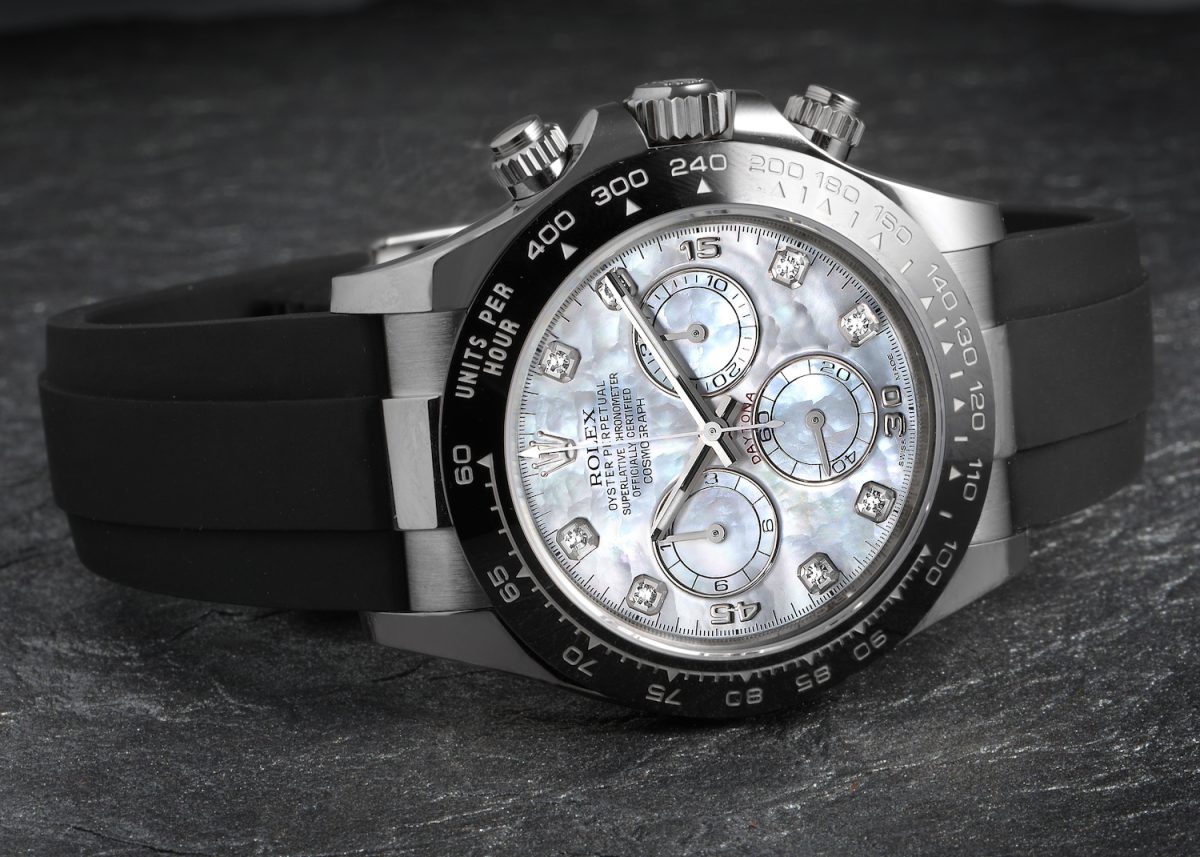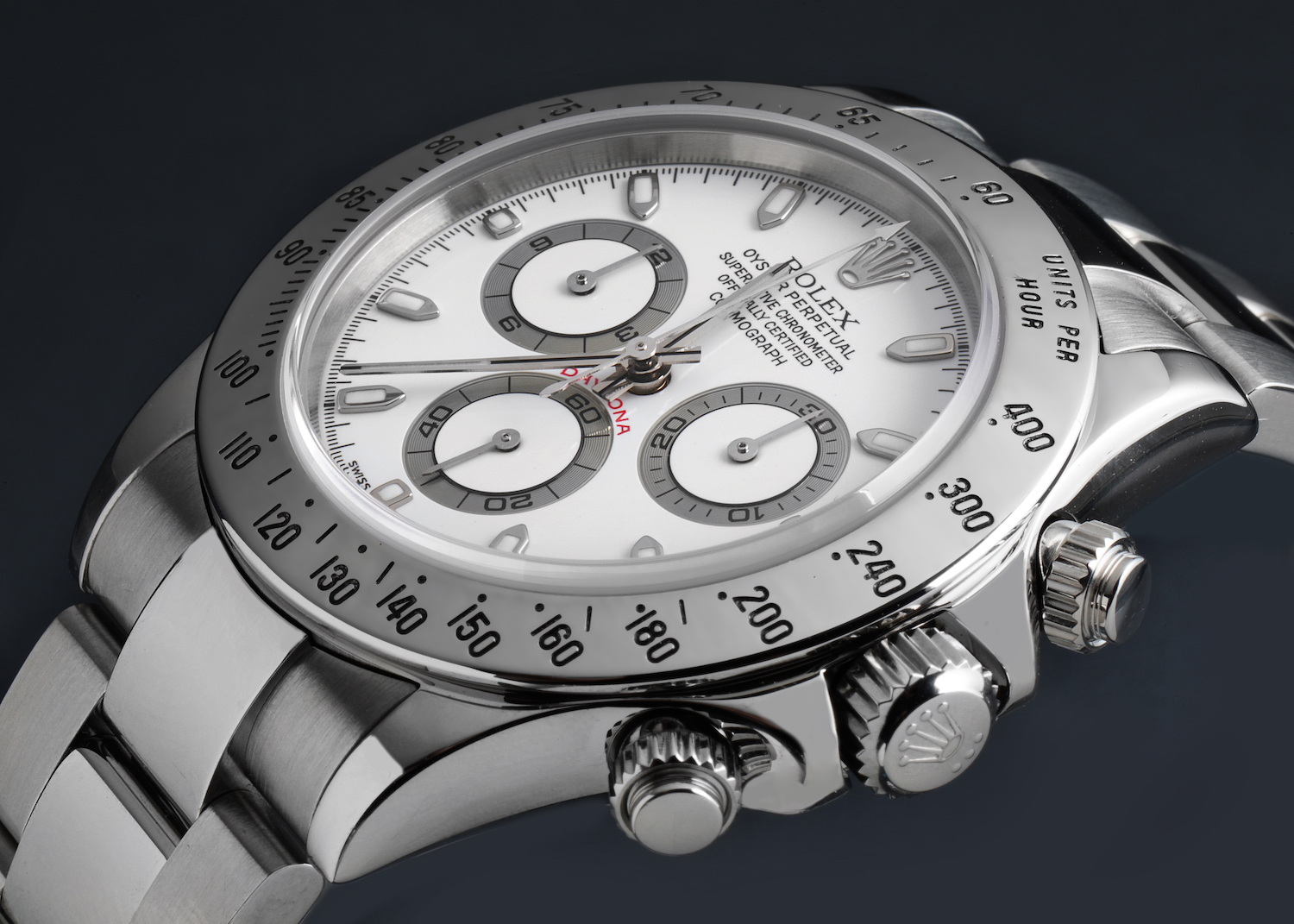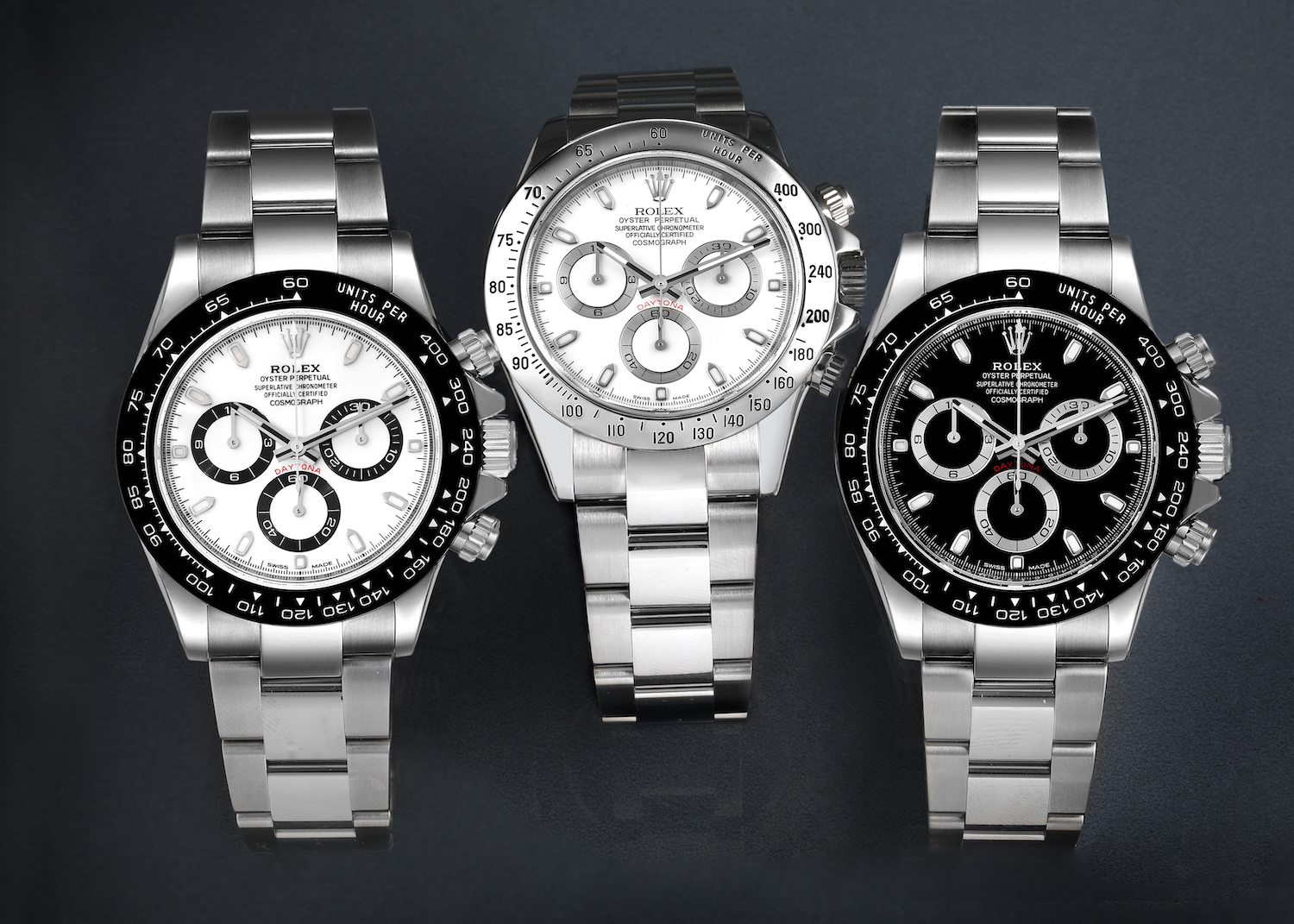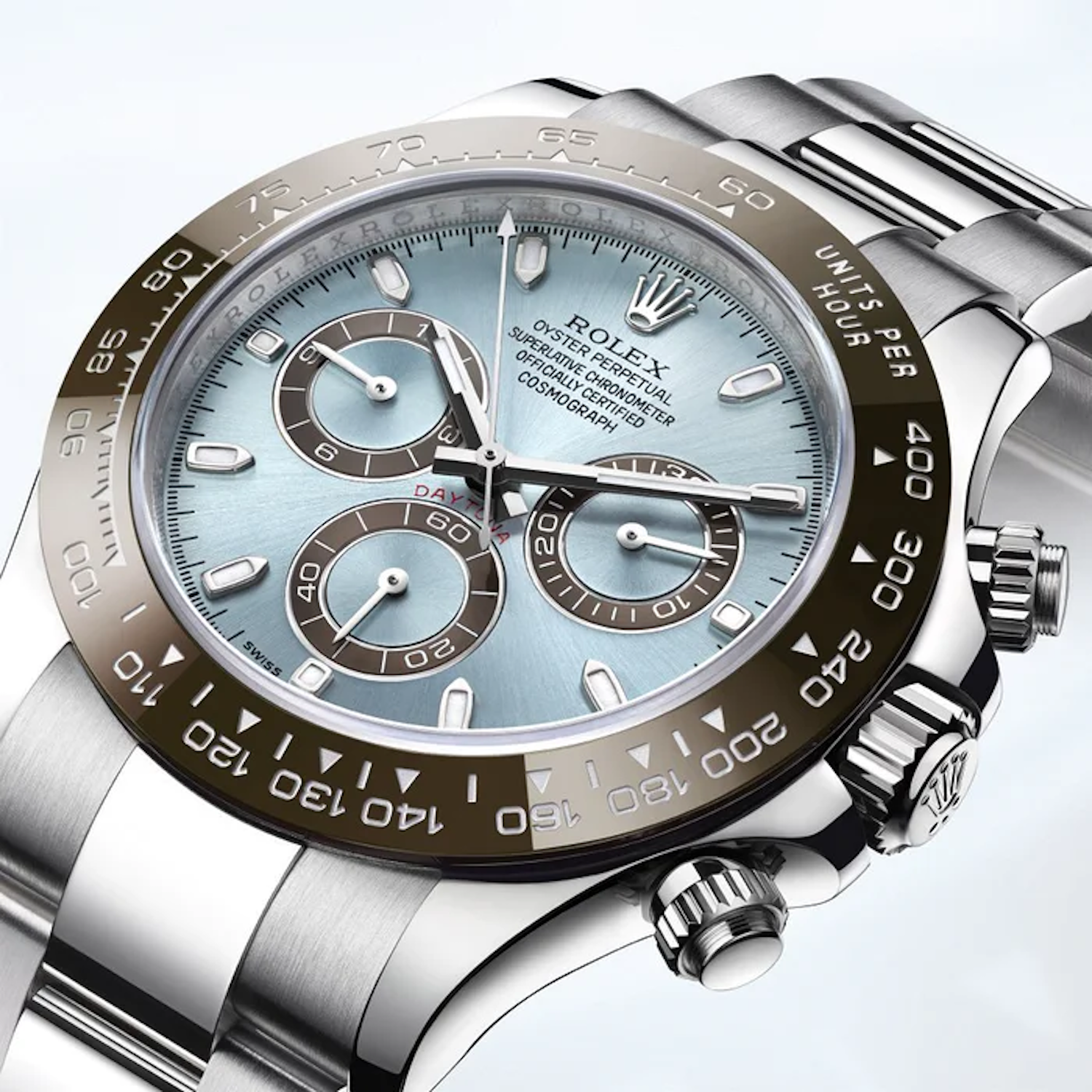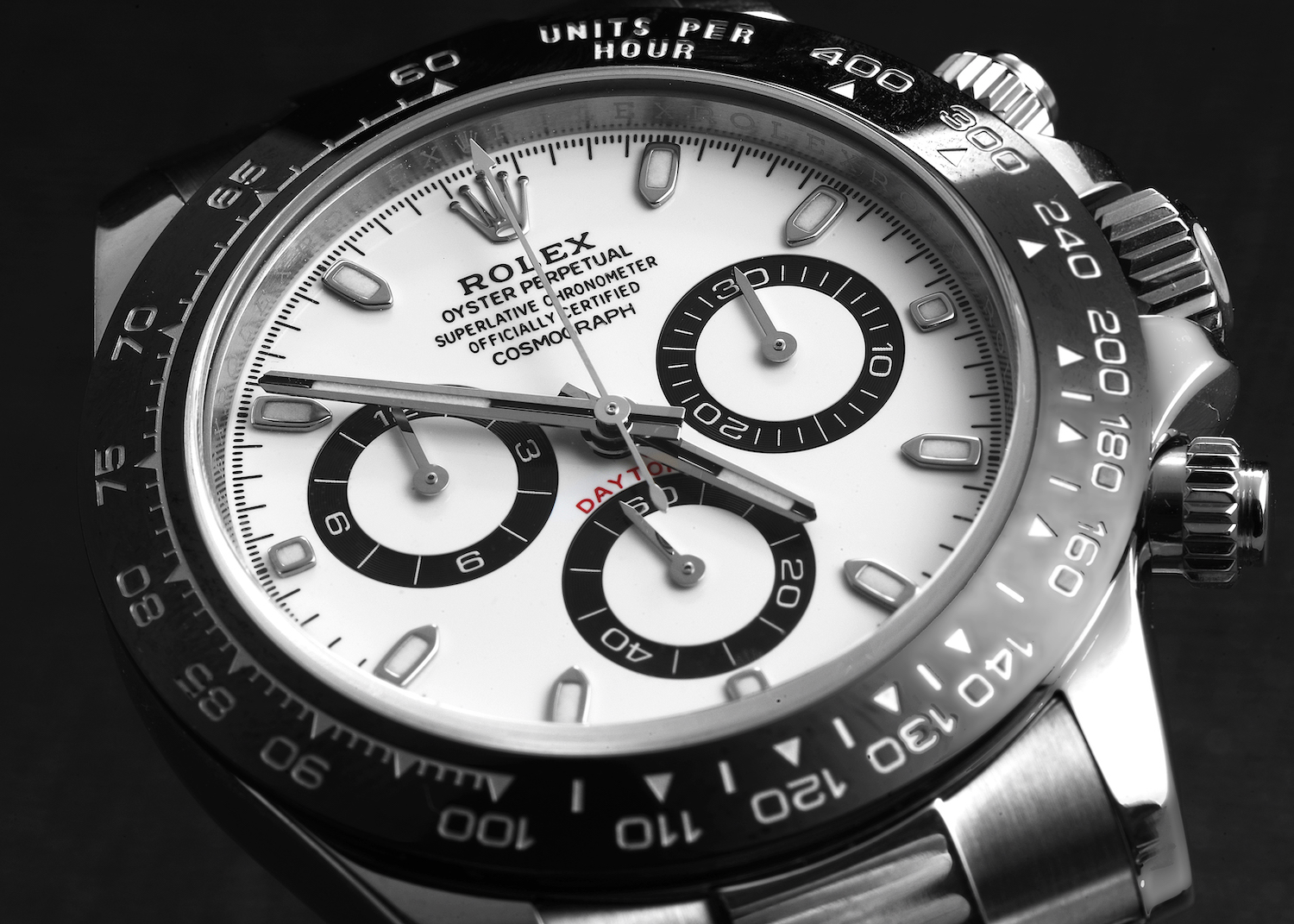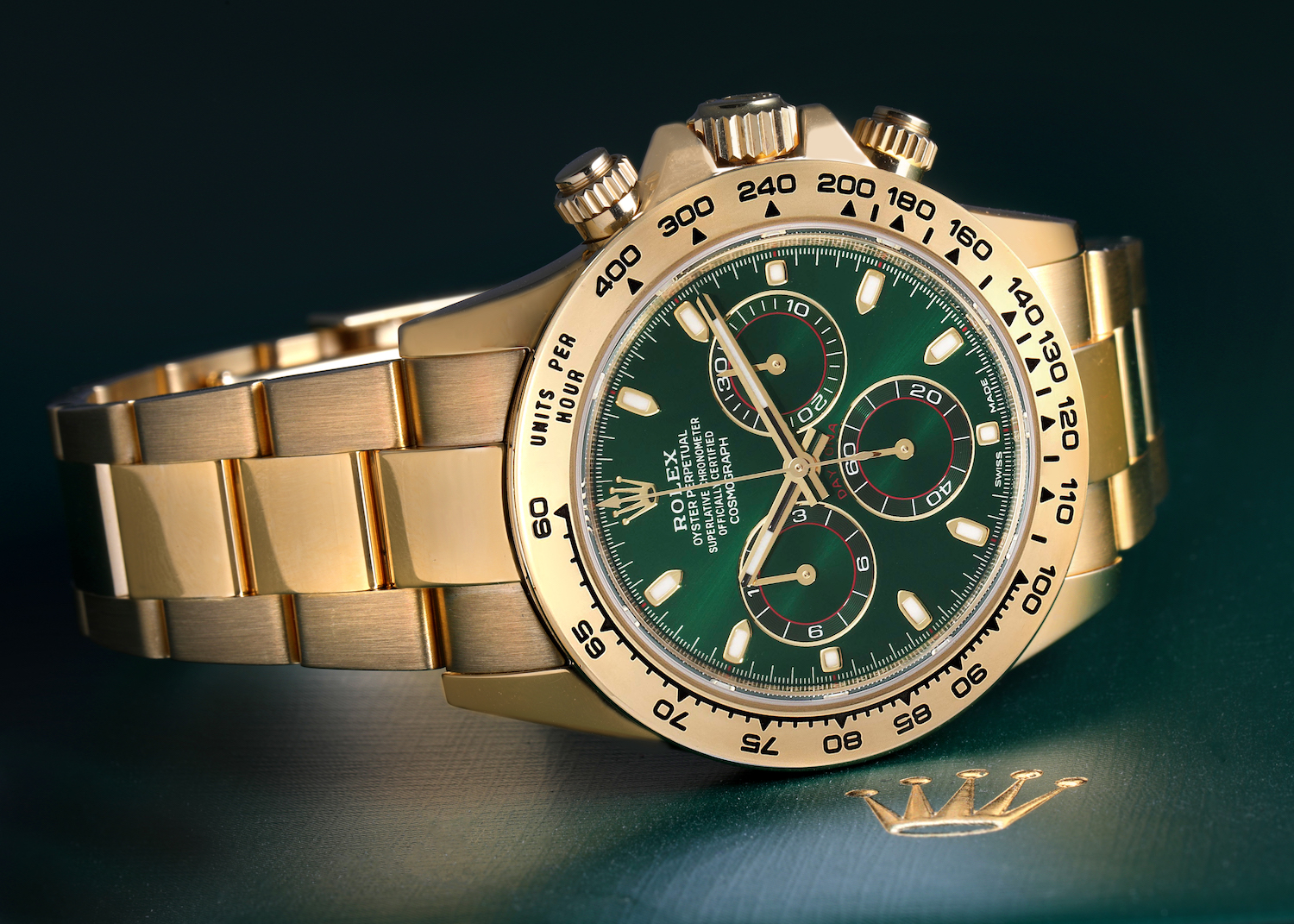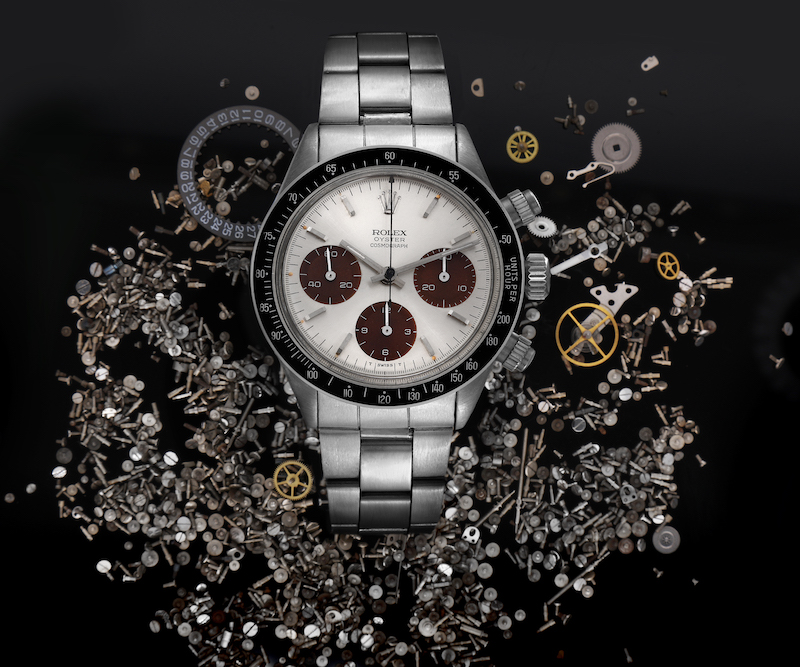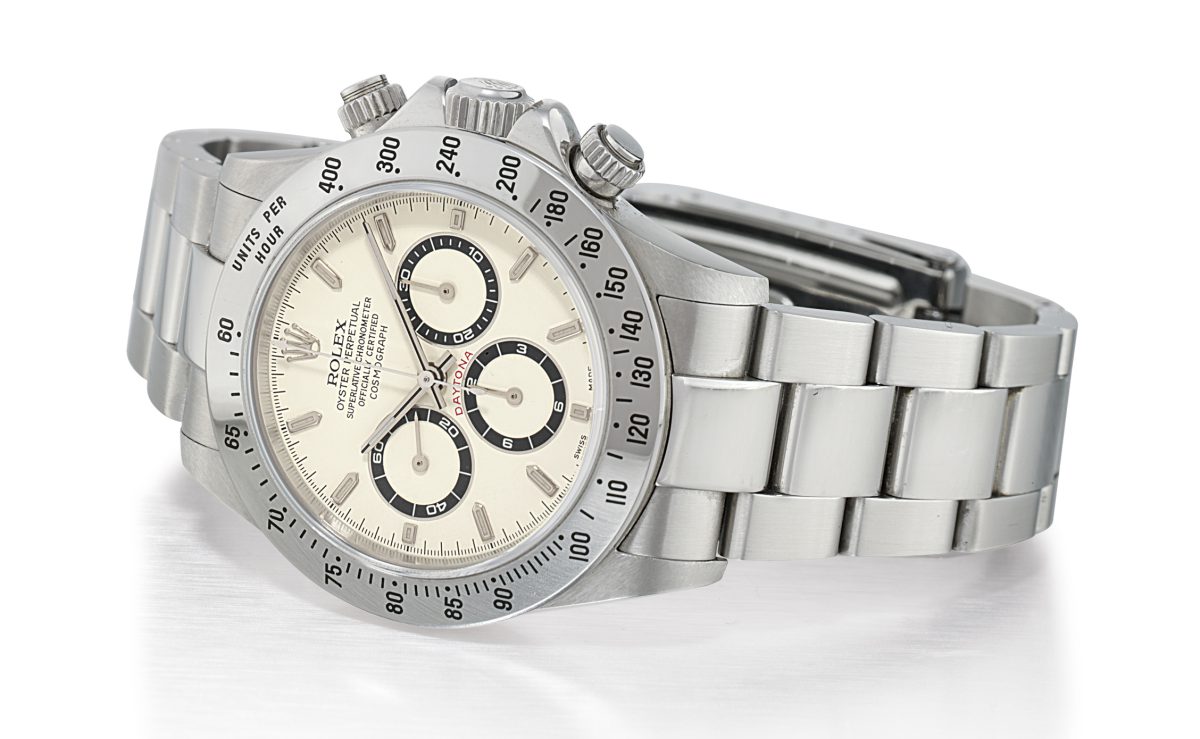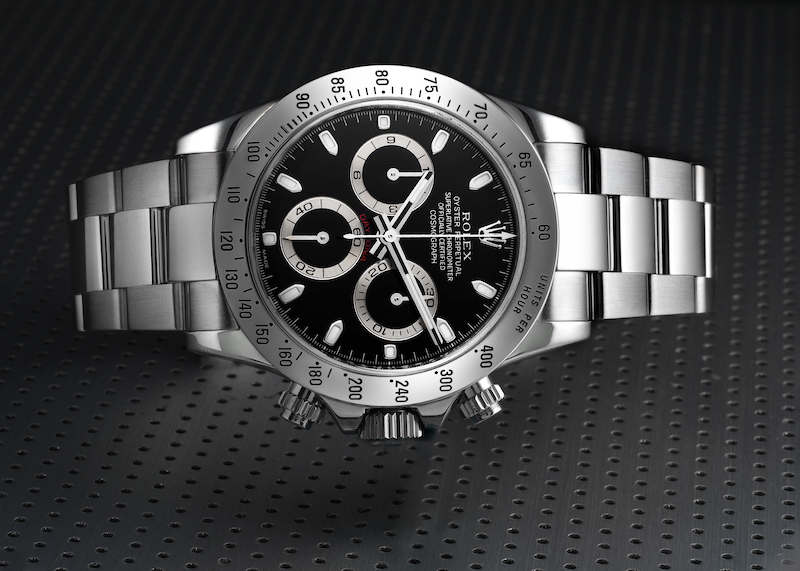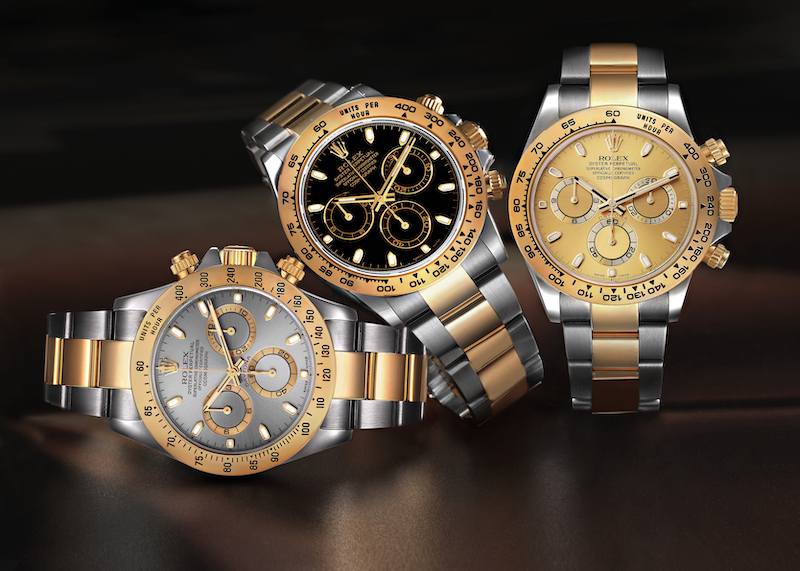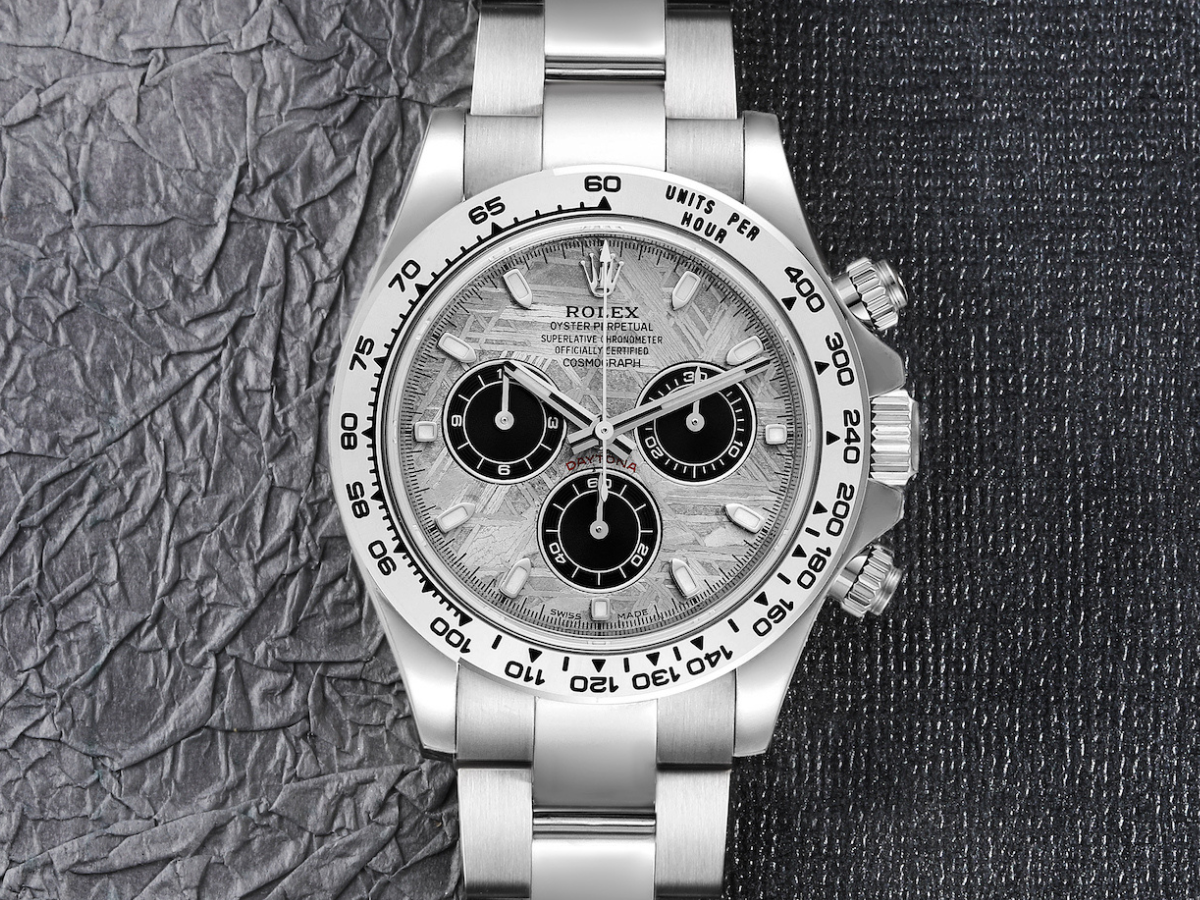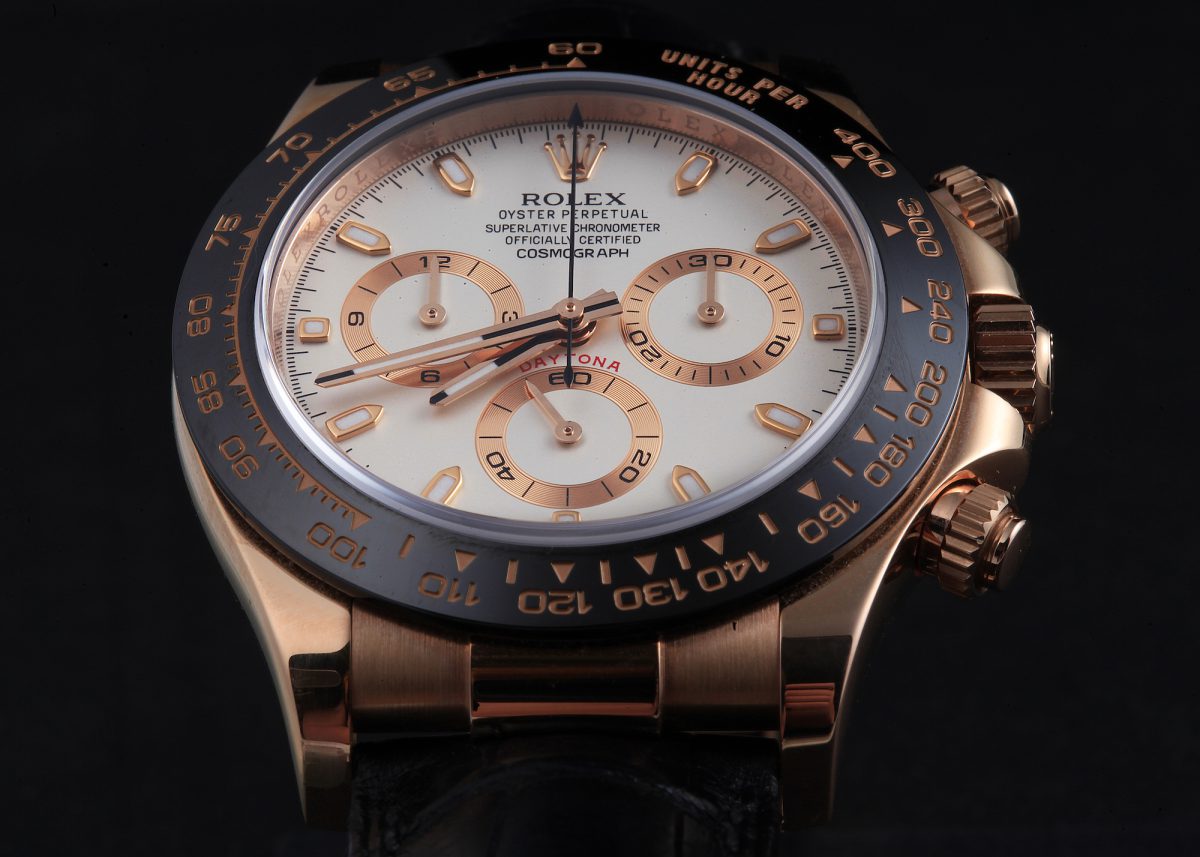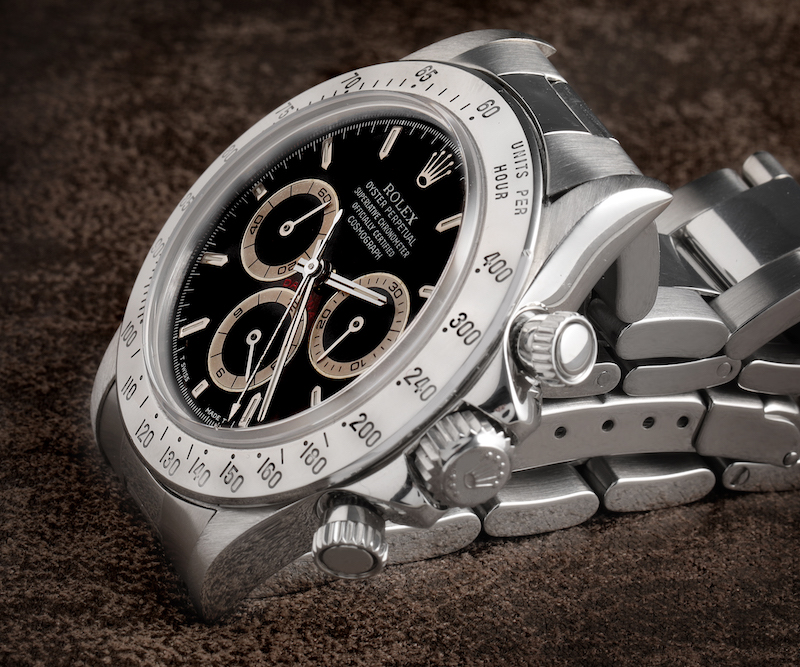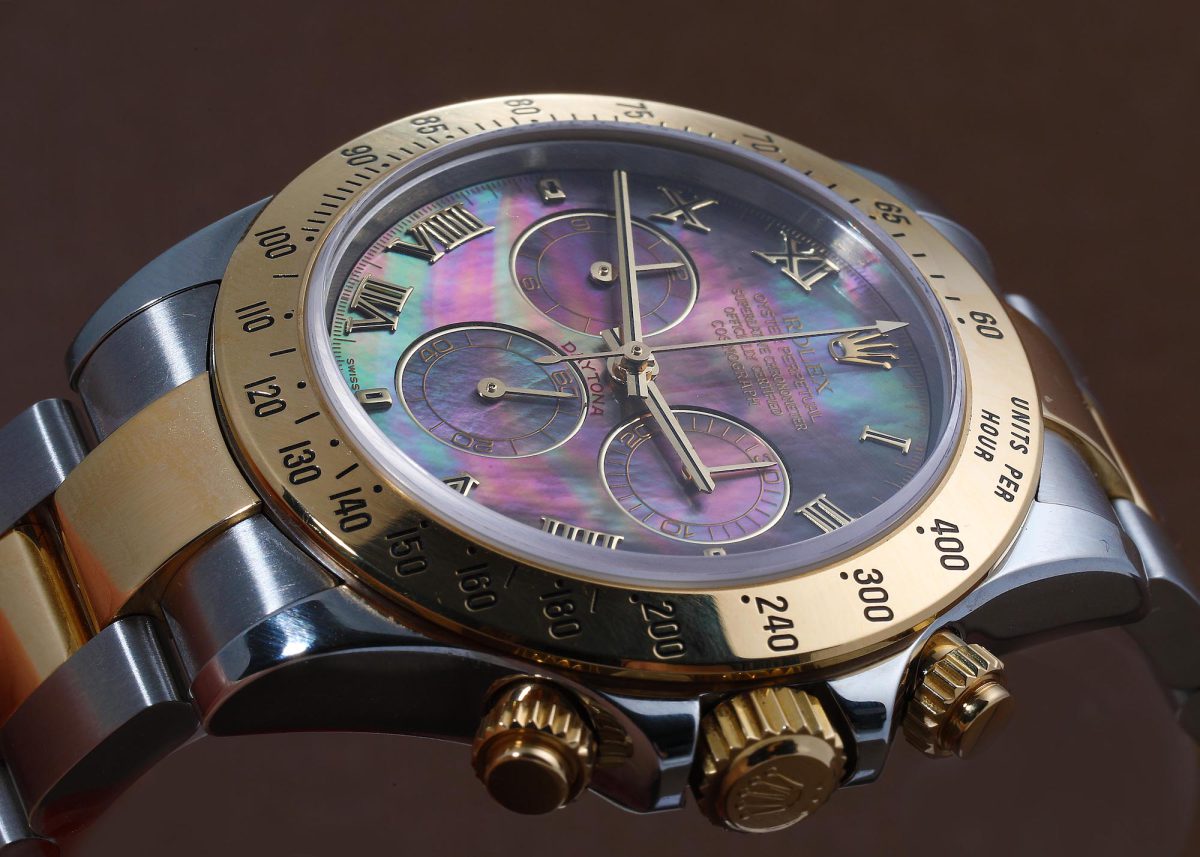The Rolex Cosmograph Daytona has gone from a watch that could hardly sell to a true industry classic. Introduced in 1963, it was developed for professional race car drivers who needed a highly reliable tool to calculate speeds and measure elapsed time.
With a little help from the legendary actor Paul Newman, and the increasing interest in vintage watches, the tides turned for the Rolex Daytona. Today, it is widely considered as the most iconic chronograph – one that every collector wants in their watch box.
The Rolex Daytona celebrates its 60th anniversary in 2023, and fans are growing curious about how The Crown will celebrate this occasion.
In the meantime, let’s brush up on our Rolex Daytona knowledge with the help of SwissWatchExpo’s ultimate guide.
Rolex Cosmograph Daytona White Gold MOP Diamond Dial Mens Watch 116519
About the Rolex Daytona
Many view the Rolex Daytona as the “Rolex chronograph”, but the brand actually began producing chronograph watches as early as the 1930s.
What set the earliest Daytona models apart and paved the way for the creation of the collection, were two pivotal decisions: in 1963, when Rolex moved the tachymetric scale from the periphery of the dial to the bezel; and in 1965, when the Daytona name finally appeared on the dial. These two characteristics still help define the Rolex Daytona’s aesthetics until today.
The Rolex Daytona’s long and rich heritage is marked by the following events:
1903: The history of racing in Florida begins at Daytona Beach and Ormond Beach. From its beginnings as a pastime for the rich, it slowly becomes a popular sport, and Daytona, Florida rises as the World Capital of Speed.
1935: British racer Sir Malcolm Campbell becomes the first person to drive over 300 miles per hour, while wearing a Rolex Oyster
1959: The Daytona International Speedway opens and becomes the home of the Daytona 500, the most prestigious and important race in NASCAR
1962: Rolex becomes the official timekeeper of the Daytona International Speedway
1963: The first Rolex Daytona watch is introduced. The ref 6239 has its tachymeter scale engraved on the metal bezel to enhance the legibility of the dial.
1965: The word “Daytona” first appears on the dial. In the same year, Rolex introduced the “exotic” dial, characterized by a contrasting outer seconds track, and Art Deco font on the chronograph registers
Late 1960s: Actor and racer Paul Newman becomes a devotee of the Rolex Daytona “exotic” dial, often wearing it to his races
1980s: Collectors give the nickname “Paul Newman” to this particular Daytona dial, and interest in earlier Daytona models grows among watch collectors
1988: The second generation of Daytona watches are equipped with self-winding movements
2000: The third generation of Daytona watches are upgraded with Rolex’s first in-house chronograph movement, the Caliber 4130
2017: Paul Newman’s personal Daytona becomes the most expensive Rolex wristwatch ever sold at auction, amounting to $17.8 million
Key Features of the Rolex Daytona
Whether they’re vintage or modern, all Rolex Daytona watches are sports chronographs used to measure elapsed time and calculate average speeds. The aesthetics of the Rolex Daytona has evolved through the decades, but the following components remain:
Rolex Daytona Steel White Dial Chronograph Mens Watch 116520
SPORTY CASE
The Rolex Daytona was originally crafted in stainless steel, but over the decades, Rolex has made versions in precious metals, helping it evolve into a luxury watch and collector’s item. Today, the Daytona is available in a combination of Oystersteel and 18-carat gold, Everose gold, yellow gold, white gold, or platinum. The use of 18-carat gold provides durability and makes scratches easy to wipe away. As a result, whether made of Oystersteel, gold, or a combination of the two, the Daytona can withstand the rigors of daily life.
TACHYMETER BEZEL
The Rolex Daytona has always had a tachymeter scale, which measures speed based on time traveled over a fixed distance. It appeared on the perimeter of the dial in earlier models, then was eventually transferred to the bezel to improve the dial’s readability.
Materials used for the tachymeter bezel have also varied through the years. A black acrylic bezel was used on a sister reference of the inaugural ref 6234.
Second-generation Rolex Daytonas have bezels made of precious metals, while the Cerachrom ceramic bezel was introduced in third-generation models. Cerachrom, which starts off as extremely fine zirconium, then mixed with pigments and a binding agent that allows it to be molded, is one of the most desirable traits of Rolex watches. It was initially seen on the 50th anniversary GMT-Master II and quickly gained traction due to its scratch- and fade-resistant properties, unrivaled hardness, rich hue, and gorgeous gloss.
The first Daytona to feature a Cerachrom bezel is the Everose Daytona, which was released in 2011 Baselworld, with either a cream or chocolate dial. The Daytona Platinum came out shortly after in 2013, which had a 950 platinum case, paired with a chestnut brown Cerachrom bezel and a beautiful ice-blue dial. Lastly, we have the 2016 Daytona in steel, which is one of the hottest sports watches in the world today. Its screw-down pushers and large red Daytona logo were inspired by vintage Big Red Daytona models, while the black Cerachrom bezel gives it a crisp look.
Today’s Daytona references only feature Cerachrom or solid gold bezels. However, there are rare and exclusive models that came equipped with gem-set bezels such as the “Leopard Daytona” and “Rainbow Daytona”, with the tachymetric scale swapped out for diamonds or other precious stones such as sapphires, rubies, and emeralds.
Rolex Daytona Everose Gold Diamond Dial Mens Watch 116515 and Rolex Daytona Everose Gold Mens Watch 116515
PUSHERS
The first chronograph watches from Rolex were equipped with single push buttons on the side, eventually switching to pump chronograph pushers.
In 1965, Rolex equipped the Daytona with screw-down pushers to improve water resistance and robustness. These would eventually become integral to the design.
CHRONOGRAPH SUBDIALS
The Rolex Daytona has two upper, contrasting subdials at 3 and 9 o’clock. The one at 3 o’clock registers the minutes, while the one at 9 o’clock registers the hours. The subdial at 6 o’clock indicates the running small seconds of the watch.
Before the year 2000s, the running seconds sub-dial was at the 9 o’clock position. It was moved down to the 6 o’clock spot to give the dial a better balance along its vertical axis.
OYSTER BRACELET
Most Rolex Daytona models are equipped with three-link Oyster bracelets, either in stainless steel, steel and gold, solid gold, or platinum. There are a few exceptions to these: vintage models with five-link bracelets, and modern 18k gold references that are fitted with either leather straps or Oysterflex rubber bracelets with matching gold clasps.
STYLISH AND LEGIBLE DIALS
The dials of the Rolex Daytona have always been eye-catching and legible. Their design is intended to assist drivers in planning their track times. First-generation models featured white, black, silver, or champagne dials with sub-dials in contrasting colors.
One of the most iconic Daytona designs ever manufactured is the Paul Newman dial, which is characterized by a stepped minute track in a contrasting color, and numbers in an Art Deco style font on its sub-dials. It is perfect for individuals who prefer their watches to be bold and loud. Hollywood actor Paul Newman possessed one of these unique dial Daytonas, and after being seen in public wearing one, their value and appeal began to grow.
Second-generation Daytona watches in steel were made available with either black or white dials only. However, those forged out of precious metals come with silver, champagne, blue, green, chocolate brown, pink, and ice blue options, among others. Along with the modernized meteorite dials that were added to the 2021 solid gold Daytona models, there are also other stone dials like lapis lazuli, sodalite, grossular garnet, and white or Tahitian mother of pearl, which has a deep purple hue mixed with pinkish and green tones.
Rolex Daytona White Gold Sodalite Diamond Dial Mens Watch 116519
CAPABLE MOVEMENTS
Rolex Daytona movements are known to be accurate, reliable, and durable. Their parts form a structure that represents an abundance of engineering and precision that movements from other brands simply don’t match. Moreover, Rolex’s design intent for their mechanisms is to handle just about anything the wearer can throw its way.
Historically speaking, the Daytona started out as a manually-wound mechanical timepiece, using Valjoux 72, 722, or 727 chronograph movements for the 37mm models. The Valjoux 727 was the most significant, increasing the frequency to 21,600 vibrations per hour, compared to the 18.000 BPH of the previous models.
Rolex began using self-winding movements in the second generation of Daytona watches. The Swiss company, however, did not have its own automatic chronograph movement at the time, so they turned to Zenith for its renowned El Primero caliber. They tweaked the El Primero according to their own standards, replacing a significant number of parts, changing its frequency, and labeling it the Caliber 4030. In collecting circles, the second generation of Daytona watches is commonly referred to as “Zenith Daytonas.”
The third series of Daytona movements is perhaps the most interesting to collectors and fans of the brand since it was the first in-house Rolex chronograph movement employed inside this renowned watch. In 2000, Rolex introduced the Caliber 4130, which was created with ultimate precision and dependability in mind. This movement has fewer components but is far more reliable and easy to maintain. It also features a 72-hour power reserve and a vertical clutch system, which prevents amplitude loss and “jitter” while starting or stopping the chronograph complication.
Rolex Caliber 4130
Three Generations of the Rolex Daytona
Over its 60-year history, the Rolex Daytona has undergone three major transformations. These are generally referred to as the three ‘generations’ of Rolex Daytona watches.
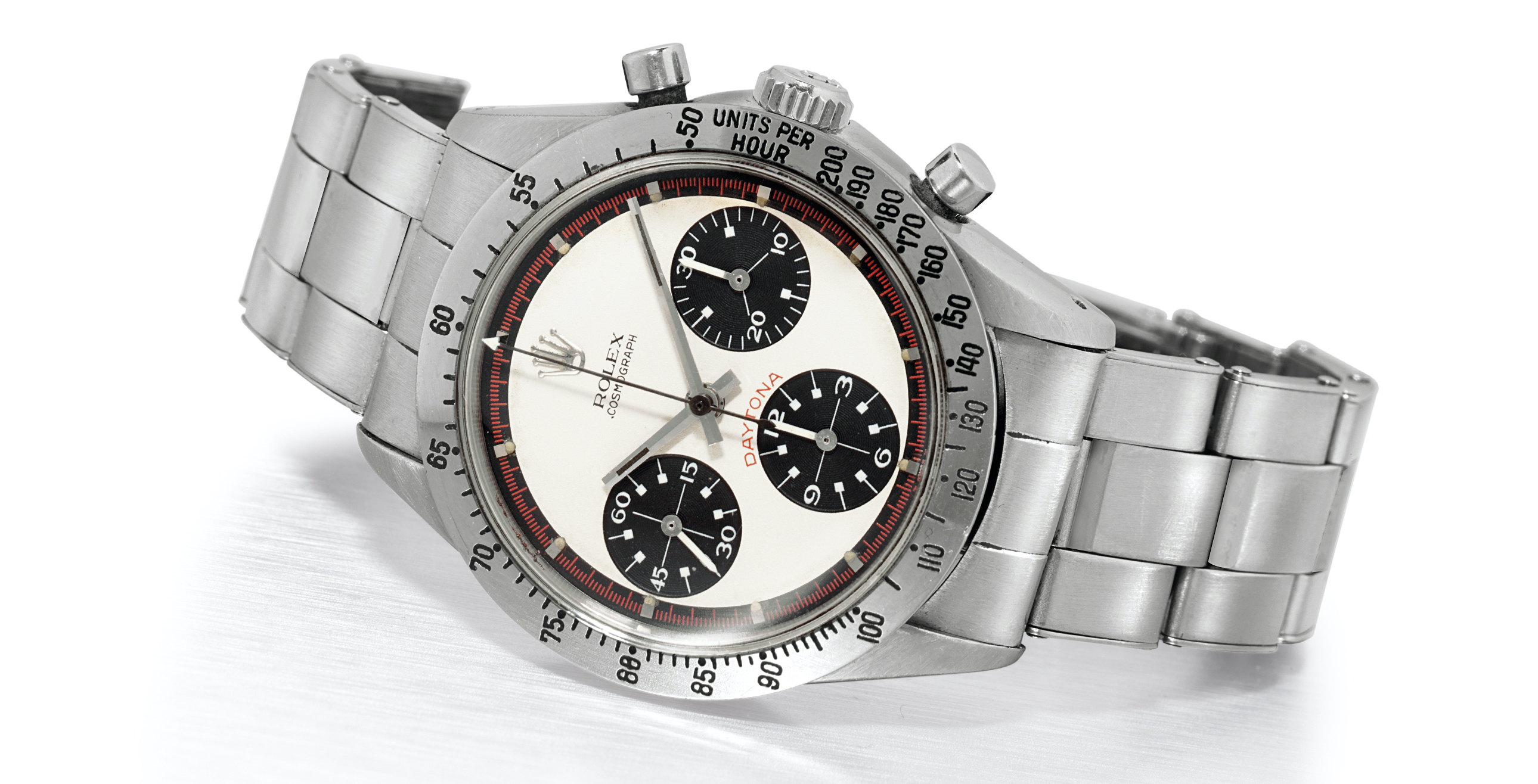 Rolex Cosmograph Daytona “Paul Newman” ref 6239 (photo: Christies)
Rolex Cosmograph Daytona “Paul Newman” ref 6239 (photo: Christies)
FIRST GENERATION (1963 – 1988)
Reference Numbers: 6239, 6241, 6240, 6262, 6264, 6265, 6263 and 6269 / 6270
Movements: Manual Valjoux 72, Valjoux 722, Valjoux 727
The original series of the Rolex Daytona had four-digit reference numbers and manual-wind movements. The movement sets this generation apart from the two succeeding series, which had self-winding movements. It was also during this generation that screw-down pushers and tachymeter bezels were introduced.
Reference | Approx. Years | Materials | Movement |
| 6239 | 1963 – 1969 | Stainless Steel, 14k Gold, 18k Gold | Valjoux 72 / Valjoux 722 |
| 6241 | 1965 – 1969 | Stainless Steel, 14k Gold, 18k Gold | Valjoux 722 |
| 6240 | 1965 – 1969 | Stainless Steel | Valjoux 72 / Valjoux 722 |
| 6262 | 1970 – 1971 | Stainless Steel, 14k Gold, 18k Gold | Valjoux 727 |
| 6264 | 1970 – 1971 | Stainless Steel, 14k Gold, 18k Gold | Valjoux 727 |
| 6265 | 1971 – 1988 | Stainless Steel, 14k Gold, 18k Gold | Valjoux 727 |
| 6263 | 1971 – 1988 | Stainless Steel, 14k Gold, 18k Gold | Valjoux 727 |
| 6269/6270 | 1980s | 18k Gold | Valjoux 727 |
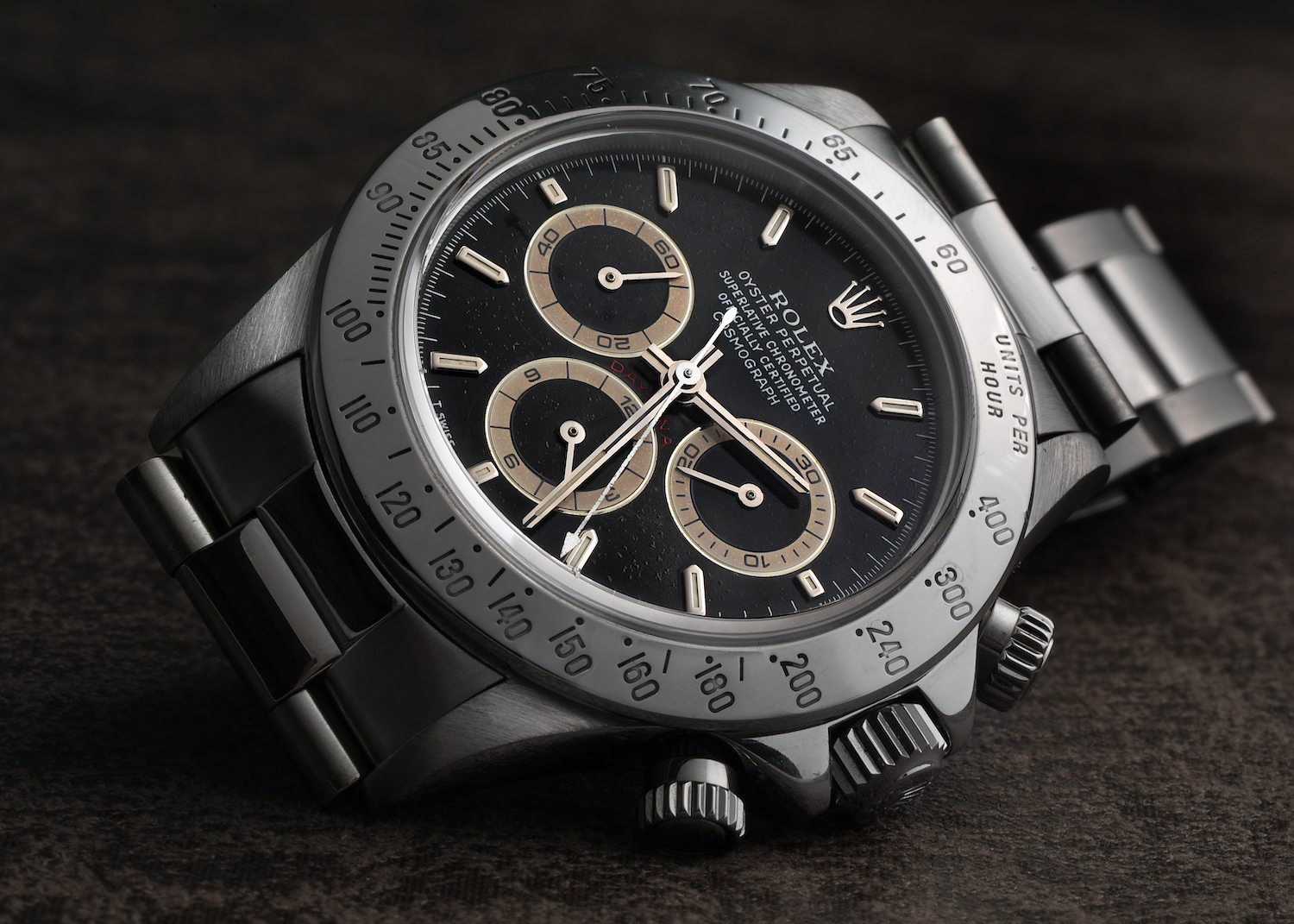 Rolex Daytona Black Patrizzi Dial Steel Mens Watch 16520
Rolex Daytona Black Patrizzi Dial Steel Mens Watch 16520
SECOND GENERATION (1988 – 1999)
Reference Numbers: 16520, 16523, 16528, 16518, 16568, 16519, 16588, 16589, 16559 and 16598
Movements: Caliber 4030
The second generation of the Rolex Daytona used five-digit reference numbers, and were the first to be equipped with self-winding movements. This generation is considered the transition of the Rolex Daytona from the vintage era to the modern era.
During this period, the following improvements were introduced:
– increased case diameter from 37mm to 40mm
– switch to sapphire crystal from acrylic crystals
– hour markers changed from blocks to elongated arrow head markers sub-dials with contrasting outer track
These changes put the Daytona towards a contemporary standard. However, the movement has yet to become completely in-house, as the Caliber 4130 was based on the Zenith El Primero’s Caliber 400 movement.
Reference | Production Years | Materials | Bracelet/Strap | Movement |
| 16520 | 1988 | Stainless Steel | Oyster Bracelet | Caliber 4030 |
| 16523 | 1988 | Stainless Steel + 18k Yellow Gold | Oyster Bracelet | Caliber 4030 |
| 16528 | 1988 | 18k Yellow Gold | Oyster Bracelet | Caliber 4030 |
| 16518 | 1992 | 18k Yellow Gold | Leather Strap | Caliber 4030 |
| 16568 | 1994 | 18k Yellow Gold, Diamond Bezel | Oyster Bracelet | Caliber 4030 |
| 16568 EMRO | 1996 | 18k Yellow Gold, Emerald Bezel | Oyster Bracelet | Caliber 4030 |
| 16519 | 1997 | 18k White Gold | Leather Strap | Caliber 4030 |
| 16588 SAFU | 1997 | 18k Yellow Gold, Pink Sapphire Bezel | Leather Strap | Caliber 4030 |
| 16589 BRIL | 1997 | 18k White Gold, Diamond Bezel | Leather Strap | Caliber 4030 |
| 16589 SAPH | 1997 | 18k White Gold, Blue Sapphire Bezel | Leather Strap | Caliber 4030 |
| 16589 RUBI | 1997 | 18k White Gold, Ruby Bezel | Leather Strap | Caliber 4030 |
| 16559 SAPH | 1998 | 18k White Gold, Blue Sapphire Bezel | Oyster Bracelet | Caliber 4030 |
| 16559 RUBI | 1999 | 18k White Gold, Ruby Bezel | Leather Strap | Caliber 4030 |
| 16559 SACO | 1999 | 18k White Gold, Cognac Sapphire Bezel | Leather Strap | Caliber 4030 |
| 16598 EMRO | 1999 | 18k Yellow Gold, Emerald Bezel | Leather Strap | Caliber 4030 |
Rolex Daytona Steel ref 116520 and Rolex Daytona Ceramic Bezel 116500
THIRD GENERATION (2000 – present)
Reference Numbers: 116500, 116503, 116515, 116505, 116508, 116518, 116519, 116509, 116506
Movements: Caliber 4130
The third generation of the Rolex Daytona was introduced in 2000, and remains in production today. This generation makes use of six-digit reference numbers, and were the first to be equipped with Rolex’s in-house chronograph movement, the Caliber 4130.
The series introduced the following features that we see in Rolex Daytona today:
– introduction of the first models to be made in platinum, white gold & Everose gold
– introduction of the first models to be equipped with Cerachrom ceramic bezels
– introduction of the leather strap and Oysterflex strap options
– running seconds sub-dial relocated from 9 o’clock to the 6 o’clock position
| Reference | Approx. Year Introduced | Materials | Bracelet/Strap | Movement |
| 116500 | 2000 | Stainless Steel | Oyster Bracelet | Caliber 4130 |
| 116523 | 2000 | Stainless Steel + 18k Yellow Gold | Oyster Bracelet | Caliber 4130 |
| 116528 | 2000 | 18k Yellow Gold | Oyster Bracelet | Caliber 4130 |
| 116518 | 2000 | 18k Yellow Gold | Leather Strap | Caliber 4130 |
| 116519 | 2000 | 18k White Gold | Leather Strap | Caliber 4130 |
| 116568 | 2001 | 18k Yellow Gold Baguette Diamond Bezel | Oyster Bracelet | Caliber 4130 |
| 116509 | 2004 | 18k White Gold | Oyster Bracelet | Caliber 4130 |
| 116598 SACO | 2004 | 18k Yellow Gold, Cognac Sapphires | Leather Strap | Caliber 4130 |
| 116505 | 2008 | 18k Everose Gold | Oyster Bracelet | Caliber 4130 |
| 116599 4RU | 2009 | 18k White Gold, Baguette Diamonds and Rubies | Oyster Bracelet | Caliber 4130 |
| 116589 RBR | 2009 | 18k White Gold, Double Diamond Row | Oyster Bracelet | Caliber 4130 |
| 116515 LN | 2011 | 18k Everose Gold, Cerachrom | Leather Strap | Caliber 4130 |
| 116598 RBOW | 2012 | 18k Yellow Gold, Multi-Colored Sapphires | Oyster Bracelet | Caliber 4130 |
| 116599 RBOW | 2012 | 18k White Gold, Multi-Colored Sapphires | Oyster Bracelet | Caliber 4130 |
| 116506 | 2013 | Platinum, Cerachrom | Oyster Bracelet | Caliber 4130 |
| 116576 TBR | 2014 | Platinum, Baguette Diamonds | Oyster Bracelet | Caliber 4130 |
| 116500 LN | 2016 | Stainless Steel | Oyster Bracelet | Caliber 4130 |
| 116503 | 2016 | Stainless Steel + 18k Yellow Gold | Oyster Bracelet | Caliber 4130 |
| 116508 | 2016 | 18k Yellow Gold | Oyster Bracelet | Caliber 4130 |
| 116518 LN | 2017 | 18k Yellow Gold, Cerachrom | Oysterflex Bracelet | Caliber 4130 |
| 116519 LN | 2017 | 18k White Gold, Cerachrom | Oysterflex Bracelet | Caliber 4130 |
| 116515 LN | 2017 | 18k Everose Gold, Cerachrom | Oysterflex Bracelet | Caliber 4130 |
| 116595 RBOW | 2018 | 18k Everose Gold, Multi-Colored Sapphires | Oyster Bracelet | Caliber 4130 |
| 116578 SACO | 2019 | 18k Yellow Gold, Cognac Sapphires | Oyster Bracelet | Caliber 4130 |
| 116588 SACO | 2019 | 18k Yellow Gold, Cognac Sapphires | Oysterflex Bracelet | Caliber 4130 |
| 116588 TBR | 2019 | 18k Yellow Gold, Baguette Diamonds | Oysterflex Bracelet | Caliber 4130 |
Popular Rolex Daytona Models
There is a broad range of Rolex Daytona watches available, but there are a few that have become cult classics. Here are the most popular Rolex Daytona models of the modern era.
ROLEX DAYTONA PLATINUM ref 116506
This model was introduced in 2013, marking the 50th anniversary of the Rolex Daytona. To celebrate the occasion, this commemorative reference was crafted in the noblest of all metals – platinum. The ultra-luxe material is hardly the norm for sport chronographs, and the prestige continues with its rich chestnut brown tachymeter bezel made of Cerachrom, Rolex’s patented ceramic, and the glacier blue dial – a shade used exclusively by Rolex for its platinum watches.
ROLEX DAYTONA CERAMIC ref 116500
Rolex had first introduced the then novel Cerachrom bezel to its Everose (ref 116515) and platinum (ref 116506) models, and fans eagerly awaited for the stainless steel version. When it was introduced in 2016, it became the most in-demand watch of the year, and until today has years-long waiting lists at authorized dealers.
What makes it so desirable is that it converges almost six decades of Rolex Daytona design in one watch. Many of its traits are visual references to iconic Rolex Daytonas of the past (such as the ref 6263 and 6265), combined with advancements of modern Daytonas.
ROLEX DAYTONA GREEN DIAL ref 116508
One of the most recent references to make waves is the green dial Rolex Daytona. Launched in Baselworld 2016, the watch is constructed in solid 18k gold and paired with a deep “racing green” dial and red “Daytona” text.
This sleeper hit had a slow start until Grammy-winning artist and known watch collector John Mayer showed off his own Daytona Green Dial in Hodinkee’s Talking Watches. John picked it up when not many collectors would, and recognized its potential for being a future grail watch. Today, it can be seen on many celebrities’ wrists including Jonah Hill and Ellen, and many collectors can’t wait to get their hands on this timepiece.
Rolex Pre-Daytona ref 6240 (photo: Christie’s)
ROLEX DAYTONA ref 6240
In 1988, the manual-winding Daytona was dropped from the Rolex catalog and was replaced with a modern edition with bigger cases, lively dials, sapphire crystals, and an automatic movement powering the chronograph. Much like the original Daytona, the second series of Daytona watches has also reached a cult-like status with Rolex fans, due, in large part, to the limited production of this particular model.
The ref. 6240 is among the standout second-generation Daytonas Rolex has ever produced. It was the first chronograph from the brand to come with screw-down chronograph pushers, which were intended to lock the two pushers in place, increasing the watch’s water resistance. A true prototype for many sports timepieces today, it was crafted to answer the demand for a true waterproof Daytona.
Housed in a 37.5 mm steel case and available with an acrylic “Bakelite” tachymeter bezel and dials in black, white, or silver, the ref. 6240 runs on the Valjoux 722 movement, which offers a 48-hour power reserve. Only roughly 1,700 pieces of the ref. 6240 are thought to have been produced.
Rolex Cosmograph Daytona Zenith ref 16520 (photo: Christie’s)
ROLEX DAYTONA ref 16520
The ref. 16520, also known as the “Zenith” Daytona, hails from the second generation of Daytona watches, introduced in 1988. This is the reference that started the legacy of modern self-winding Daytonas and has quickly become a must-have sports watch of its era, thanks to its bigger size and refreshing looks.
For this watch, Rolex turned to Zenith for their famed and capable El Primero movement. The Swiss company, however, did not simply adopt the basic El Primero; they tweaked it to meet their high-performance standards and dubbed it Caliber 4030, resulting in a fantastic first-generation automatic Daytona with a renowned movement.
Apart from a larger 40mm stainless steel case (from 37mm), the ref. 16520 also came with either a white or black dial in a lacquered finish, screw-down pushers, and for the first time, a sapphire crystal and crown guards. The three chronograph sub-dials were given a contrasting outer ring, while the hour markers were replaced with lume-filled indices. There were about five different dial variations made available for this watch, which make them highly collectible, and its production lasted until 2000.
Rolex Cosmograph Daytona ref 116520
ROLEX DAYTONA ref 116520
The predecessor to the modern-day Daytona, the ref. 116520 was introduced in 2000, as part of the third generation of Daytona watches. It was the last Daytona to feature a steel bezel, giving it a unique sporty look that first appeared on the El Primero-equipped Daytona (ref.16520) in 1988.
This reference boasts many of the same features as the Zenith Daytona but with the in-house automatic Caliber 4130 under its hood. The 100-meter depth rating makes the ref. 116520 suitable for water sports and recreational swimming, while the sapphire crystal, luminous hour markers, and Oyster bracelet round out the elegant and legible package. Like its predecessor, the ref.116520 was met with great success.
Rolex Cosmograph Daytona Steel Yellow Gold ref 116503
ROLEX DAYTONA ref 116503
Lastly, we have the ref. 116503, the current two-tone Daytona, which debuted in 2016. This watch looks similar to its predecessor, the steel and gold ref. 116523 from 2000, but with a refreshed bezel. Instead of circular markings, the new bezel has beefier fonts and triangular markers. Moreover, its tachymeter scale has hash marks between the 60 to 100 graduations underlined by a bold black line, while all the numerals are circling in a curve around the bezel, instead of positioned perpendicular to the hour markers.
The biggest change for the ref. 116503, however, is the dial design. It looks a bit more contemporary than its predecessor, thanks to its cleaner indices, and comes with a choice of gold, white, or black hues. The watch’s rehaut also comes with “ROLEX ROLEX ROLEX” engraving, which was first introduced in the mid-2000s as an anti-counterfeit measure. All Daytona ref. 116503 watches have this interesting feature.
Inside, the timepiece runs on the same 44-jewel Caliber 4130, which offers 72 hours of power reserve. The three-piece link Oyster bracelet is the only option available for this watch and is characterized by solid flat links, a folding Oysterlock clasp, and a 5mm Easylink comfort extension system for rapid adjustment. A red Daytona logo curved above 6 o’clock adds a playful touch.
Common Questions About the Rolex Daytona
The Rolex Daytona is the most famous chronograph watch of all time, and one of Rolex’s best-selling models. Here are answers to the most frequently asked questions about the Rolex Daytona.
Rolex Daytona White Gold Meteorite Dial Mens Watch 116509
WHAT IS A ROLEX DAYTONA?
The Rolex Cosmograph Daytona is the brand’s chronograph watch, introduced in 1963. It is characterized by a tachymeter bezel, screw down pushers, and three chronograph sub-dials.
HOW CAN I TELL IF MY ROLEX DAYTONA IS REAL?
Because of the great demand for Rolex Daytona watches, they have become a target for counterfeiters. Each Rolex watch is made to the highest standards, and with top quality materials. If even a minute detail comes across as shoddy, you can be certain that it’s not the real deal.
When buying any luxury watch, it is essential to do research on your chosen model and reference. If you are familiar with its most minute details, then you can more easily spot a fake. Your best defense against buying a fake timepiece is to purchase your watch from a reputable and trusted dealer, like SwissWatchExpo, who can provide a guarantee of authenticity on the watch.
WHY ARE ROLEX DAYTONA WATCHES DIFFICULT TO OBTAIN?
Rolex Daytona watches are difficult to come by because they are made with limited production runs. This is especially true for the earliest Daytona models. Because the Rolex Daytona wasn’t popular then, production numbers were also low.
Rolex Daytona watches are also known to have years-long waitlists. When a Rolex Daytona is introduced to the market, authorized dealers usually have a roster of clients who have reserved their slot to get the timepiece. This is where buying pre-owned presents many advantages – it opens up your options to include previous versions, limited editions, and even discontinued styles.
HOW DO I WIND A ROLEX DAYTONA?
Your watch has to be wound before being worn for the first time, or if it has stopped. To wind the watch, unscrew the winding crown until it pops out of its position and is free from the threads securing it onto the case. Then, turn it several times clockwise or away from you. At least 25 turns are recommended for adequate partial winding. The watch will stay wound automatically as long as it is worn on the wrist.
WHAT IS THE WATER RESISTANCE OF ROLEX DAYTONA WATCHES?
The Rolex Daytona offers a depth rating of 100 meters. This means that the watch will have no problem hanging out in the water for a while, and will even be fine for snorkeling, water sports, sailing, and recreational surfing. The addition of screw-down pushers and a screw-down crown helped improve the Daytona’s overall reliability and water resistance.
It is worth mentioning that screw-down pushers are not created in the same way as screw-down crowns. The true purpose of the screw-down pushers is to keep the wearer from mistakenly pressing a pusher and jeopardizing the watch’s water resistance. In other words, a wearer could dive with the Daytona’s pusher screws unscrewed, although it is not encouraged.
Rolex Cosmograph Daytona Rose Gold Everose Mens Watch 116515
WHAT MAKES THE ROLEX DAYTONA SO SPECIAL?
The Rolex Cosmograph Daytona is regarded as a horological icon and one of the most admired luxury sports chronographs today. It was originally crafted for the race track but is now loved by countless A-list personalities all around the globe.
One of the things that makes the Daytona unique and so highly desired by many is its straightforward yet perfectly balanced design. Its contrasting hues, from the main dial to the subdials, and well-crafted steel or gold casing give it a sporty stylish look. Additionally, the renowned chronograph is powered by movements that have stood the test of time. From the Valjoux and El Primero to the modern-day Caliber 4130, Rolex only used mechanisms with outstanding reliability and accuracy.
The Daytona not only has a plethora of features, but it also has iconic owners. While sales were originally poor, the watch began to appear fashionable and earn a reputation among fans and collectors after it was seen on Paul Newman’s wrist in the late 1960s. His endorsement contributed to the high demand for Daytona watches, particularly vintage references. In fact, among the most sought-after Daytonas available today are those with unique dials that are linked to actor Paul Newman and distinguished by Art Deco numbers and hash marks that end in squares.
Furthermore, the Daytona denotes exclusivity and exceptional value, making it highly desirable. Some collectors are willing to pay significantly above retail to ensure that they can actually get one. Vintage models, including the Paul Newman and tropical dials, and Big Red Daytonas, are expected to further grow in value over the next few years.
10 Interesting Facts About the Rolex Daytona
1. The Rolex Daytona was named after Florida’s Daytona International Speedway.

Daytona Beach (photo: Rolex / ISC Archives via Getty Images)
“Daytona” refers to Daytona Beach in Florida, USA, which is known as the birthplace of speed. Motor racing has been taking place there since the early 1900s and is ideal for land speed record attempts. William Henry Getty “Big Bill” France Senior officially founded the Daytona International Speedway race track in 1959, which serves as the source for the Daytona’s moniker.
Unknown to many, the names Rolex and Daytona actually came together decades before the first Daytona ref. 6239 was produced in 1963. In the early 1930s, most timepieces were tested on the wrists of athletes, rather than in hi-tech laboratories as they are now. However, Rolex founder Hans Wilsdorf saw the commercial potential of motorsport and formed a collaboration with racing driver Sir Malcolm Campbell.
In March 1935, Campbell set one of his final records on the sand track at Daytona Beach, extending the world land speed record to 445.472 kilometers per hour. He wore a Rolex Oyster watch during the event and praised its exceptional resistance to shocks and vibrations. In 1991, Rolex became the primary sponsor of the 24 Hours of Daytona competition at Daytona International Speedway.
2. The Rolex Daytona was originally the least popular Rolex model.
The Daytona was reportedly so unpopular that Rolex considered stopping its production. Many customers thought the design was too daring and even had them replaced during servicing. However, thanks to famed actor and race car driver Paul Newman’s endorsement, this watch is now one of the most loved Rolex pieces, and this can be seen in the amount of money that vintage models are selling for today.
3. The Rolex Daytona hasn’t always used an in-house movement.
Rolex now uses in-house movements in all of its Daytona models, although this was not always the case. In fact, it wasn’t until the year 2000 that Rolex began producing the in-house caliber 4130 for the Daytona. Prior to this, the Rolex Daytona watch was powered by mechanisms based on Valjoux and Zenith movements.
As previously noted, the Swiss brand altered the Zenith El Primero movement by replacing a few of its components and adjusting its frequency. In fact, the movement was so substantially modified that just roughly half of the original Zenith movement remained.
4. The Cosmograph Daytona has gone through three iterations.
As emphasized above, the Rolex Daytona has seen three main alterations throughout the years. These include the following:
– The original series, which was produced in limited numbers between the 1960s to 1980s. Watches from this generation clocked in much smaller – at about 37mm – and featured an acrylic crystal and hand-wound movement manufactured by Valjoux;
– The second series, which was introduced in 1988. Watches under this classification marked the arrival of automatic movements and have always had a five-digit reference number;
– The third series, which was launched in 2000. Models from this variant retain many of the Daytona’s core design traits and have the running seconds indication at 6 o’clock instead of 9 o’clock.
5. “Cosmograph” is a term created by Rolex.
The word “Cosmograph” was coined by Rolex in the 1950s to designate a watch having moon phase and calendar complications, and it is now used to denote Daytona chronographs.
In 1953, Rolex formally registered the name Cosmograph. The early Daytonas did not have the word “Daytona” on the dial, but rather “Cosmograph,” which is a significant detail because Cosmograph is officially the original and correct name for the watch. Rolex’s chronograph watches were later promoted and known as “Rolex Daytonas,” rather than Cosmographs, but the brand never abandoned the old nomenclature, which can still be seen on all Daytona watches today.
6. The ”Paul Newman” Daytona

Rolex Paul Newman Daytona ref 6239 (photo: Sotheby’s)
Paul Newman, an American actor who competed in the 24 Hours of Daytona six times, is regarded as the man who best symbolizes and represents the Rolex Daytona. His first Daytona was a gift from his wife, Joanne Woodward, during the same film shoot that got him into cars in the first place, the movie Winning.
It was thanks to Paul Newman that the iconic chronograph became sought-after and prominent, and prices for the “Paul Newman” Daytona skyrocketed. Collectors gave the exotic dial models (references 6239, 6241, 6262, 6263, 6264, 6265) the nickname “Paul Newman Daytona” after seeing the actor wear it multiple times during car races and even his shoots. These watches already went out of production in the early 1970s, thus becoming amongst the most expensive vintage watches in existence.
7. The “Paul Newman” Daytona was the most expensive Rolex watch ever sold.
In October 2017, a steel Daytona ref. 6239, which had formerly been owned and worn by Paul Newman himself, was sold by Phillips in Association with well-known auctioneer Bacs & Russo in New York City for $17.75 million. This makes it the most expensive wristwatch ever sold at an auction, following Patek Philippe’s Grandmaster Chime Ref. 6300A-010.
Newman reportedly gave the watch away to the then-boyfriend of his daughter, James Cox, who had kept hold of it ever since 1984. It was selling for about $200 at that time and is engraved on the back with the words ‘Drive Carefully Me’ following his 1965 accident. Today, the watch belongs to an anonymous bidder who bought it over the phone. James Cox has donated a significant portion of the total sale price to the Nell Newman Foundation.
8. “Tropical” Daytonas are quite desirable.
Rolex Daytona Patrizzi Dial ref 16520
Tropical Daytonas, like all “tropical” dialed Rolexes, command a premium above the standard Daytona. These timepieces come with discolored dials, which are caused by a defect in the manufacturing process or sometimes by UV rays. While you’d expect that due to this odd trait prices would fall, it’s actually the opposite. Collectors overwhelmingly agree that ‘tropical’ dials are more visually appealing.
9. In the 70s, steel Daytonas were sold for less than one thousand dollars.
A steel Daytona retailed for $386 (not including inflation) in the 1970s and has maintained a reputation as one of Rolex’s most affordable models throughout its history. It had relatively small annual price increases up to 1986. However, in just three years, its price skyrocketed from $1,175 in 1986 to $2,350 in 1988, and then to $3,250 in 1989.
Throughout the 1990s and 2000s, the Rolex Daytona maintained its steady climbing price trend, reaching $12,000 by 2012. Despite its five-figure price tag, the steel Daytona remains the best intermediate timepiece among Rolex models.
10. The Rolex Daytona is mostly worn for everyday use today as opposed to racing.
The Rolex Daytona has ideal proportions and matures elegantly with continuous wear. Moreover, it is also as sporty and tough as any Rolex watch. While the Daytona has grown from a racing chronograph to a daily wearer, it was its involvement in motorsports that first made it famous. This heritage remains an important component of Rolex’s appeal and story.
Today, the watch remains an integral part of the Rolex horology house. It’s a status symbol, a collector’s item, a piece of history, a feat of watchmaking – the list goes on.
Rolex Daytona Steel Yellow Gold MOP Dial Chronograph Mens Watch 116523
Almost 60 years on, the Rolex Cosmograph Daytona remains in a class of its own among watches, as a reliable chronograph and style icon. Explore a wide selection of Rolex Daytona watches at SwissWatchExpo.com.

